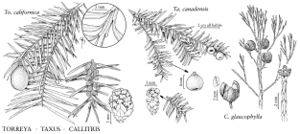Difference between revisions of "Taxaceae"
FNA>Volume Importer |
imported>Volume Importer |
||
| (7 intermediate revisions by 2 users not shown) | |||
| Line 13: | Line 13: | ||
}}<!-- | }}<!-- | ||
| − | --><span class="statement" id="st- | + | --><span class="statement" id="st-undefined" data-properties=""><b>Trees </b>or shrubs evergreen, usually neither resinous nor aromatic (sharp- or foul-odored in <i>Torreya</i>), dioecious or monoecious. <b>Bark</b> scaly or fissured. <b>Lateral</b> branches well developed, similar to leading shoots; twigs terete, not densely clothed by leaves but ± ridged by decurrent leaf bases; longest internodes less than 1 cm; buds ± inconspicuous. <b>Roots</b> fibrous to woody. <b>Leaves</b> (needles) simple, persisting several years, shed singly, alternate [opposite], spirally arranged but often twisted so as to appear 2-ranked, linear to linear-lanceolate, decurrent; resin canals present or absent. <b>Pollen</b> cones maturing and shed annually, solitary or clustered, axillary on year-old branches, globose to ovoid, sporophylls bearing 2–16 microsporangia (pollen sacs); pollen ± spheric, not winged. <b>Seed</b> cones reduced to 1–2 ovules subtended by inconspicuous, decussate bracts, maturing in 1–2 seasons, axillary on year-old branches. <b>Seeds</b> 1 per "cone," erect, not winged, hard seed coat partially or wholly surrounded by a juicy, fleshy or leathery aril; cotyledons 2.</span><!-- |
-->{{Treatment/Body | -->{{Treatment/Body | ||
| Line 84: | Line 84: | ||
|family=Taxaceae | |family=Taxaceae | ||
|illustrator=John Myers | |illustrator=John Myers | ||
| + | |illustration copyright=Flora of North America Association | ||
|distribution=Mainly Northern Hemisphere. | |distribution=Mainly Northern Hemisphere. | ||
|reference=burns1990b;canadian1983a;farjon1990a;florin1948a;hosie1969b;krussmann1972a;little1979b;pilger1903a;pilger1916a;pilger1926a;price1990a;silba1986a | |reference=burns1990b;canadian1983a;farjon1990a;florin1948a;hosie1969b;krussmann1972a;little1979b;pilger1903a;pilger1916a;pilger1926a;price1990a;silba1986a | ||
| Line 89: | Line 90: | ||
|publication year= | |publication year= | ||
|special status= | |special status= | ||
| − | |source xml=https:// | + | |source xml=https://bitbucket.org/aafc-mbb/fna-data-curation/src/2e0870ddd59836b60bcf96646a41e87ea5a5943a/coarse_grained_fna_xml/V2/V2_504.xml |
| − | |||
| − | |||
| − | |||
| − | |||
| − | |||
| − | |||
| − | |||
| − | |||
| − | |||
| − | |||
| − | |||
| − | |||
| − | |||
| − | |||
| − | |||
| − | |||
| − | |||
| − | |||
| − | |||
| − | |||
| − | |||
| − | |||
| − | |||
| − | |||
| − | |||
| − | |||
| − | |||
| − | |||
| − | |||
| − | |||
| − | |||
| − | |||
| − | |||
| − | |||
| − | |||
| − | |||
| − | |||
| − | |||
| − | |||
| − | |||
| − | |||
| − | |||
| − | |||
| − | |||
}}<!-- | }}<!-- | ||
-->[[Category:Treatment]] | -->[[Category:Treatment]] | ||
Latest revision as of 20:23, 5 November 2020
Trees or shrubs evergreen, usually neither resinous nor aromatic (sharp- or foul-odored in Torreya), dioecious or monoecious. Bark scaly or fissured. Lateral branches well developed, similar to leading shoots; twigs terete, not densely clothed by leaves but ± ridged by decurrent leaf bases; longest internodes less than 1 cm; buds ± inconspicuous. Roots fibrous to woody. Leaves (needles) simple, persisting several years, shed singly, alternate [opposite], spirally arranged but often twisted so as to appear 2-ranked, linear to linear-lanceolate, decurrent; resin canals present or absent. Pollen cones maturing and shed annually, solitary or clustered, axillary on year-old branches, globose to ovoid, sporophylls bearing 2–16 microsporangia (pollen sacs); pollen ± spheric, not winged. Seed cones reduced to 1–2 ovules subtended by inconspicuous, decussate bracts, maturing in 1–2 seasons, axillary on year-old branches. Seeds 1 per "cone," erect, not winged, hard seed coat partially or wholly surrounded by a juicy, fleshy or leathery aril; cotyledons 2.
Distribution
Mainly Northern Hemisphere.
Discussion
Genera 5, species 17–20 (2 genera, 5 species in the flora).
Selected References
Illustrations
| Family ⠉ | Taxon | Illustrator ⠉ | |
|---|---|---|---|
 | Taxaceae Taxaceae Cupressaceae | Torreya californica Taxus canadensis Callitris glaucophylla | John Myers John Myers Bobbi Angell |
Key
| 1 | Leaves flexible, without resin canal, apex mucronate, soft-pointed, not sharp to touch; aril scarlet to orange-scarlet, soft, mucilaginous, thick, cup-shaped, open at apex, exposing hard seed coat. | Taxus |
| 1 | Leaves rigid, stiff, with central resin canal, apex acute, spine-tipped, sharp to touch; aril green or green with purple streaks, leathery, resinous, thin, completely enclosing hard seed coat. | Torreya |